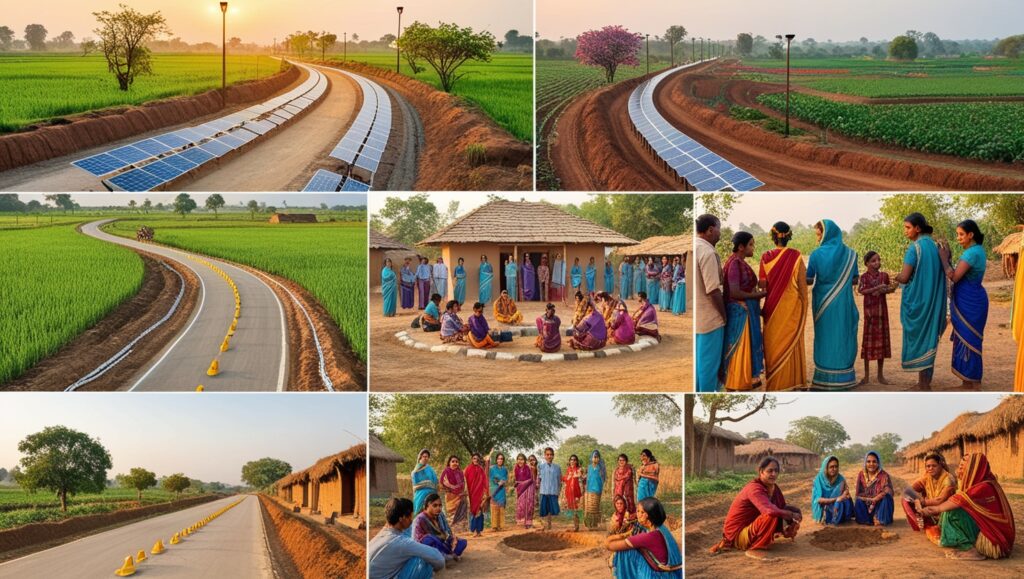Key Objectives: Why Rural Development is Important in India

Key Highlights
- Rural development programmes in India aim to achieve sustainable development and improve the quality of life for people living in rural areas.
- These programmes focus on promoting economic growth, providing essential, and reducing poverty.
- The key objectives of rural development include infrastructure development, rural livelihood enhancement, and poverty eradication.
- Improving agricultural productivity and sustainability is a crucial aspect of rural development, along with the improvement of infrastructure in rural areas.
- Strategies for achieving rural development involve empowering rural communities through education and skill development and promoting women’s participation in rural development.
- The government and NGOs play a significant role in implementing rural development initiatives and contributing to overall development.
- However, rural development also faces challenges such as poverty, climate change, and limited access to healthcare.
Introduction
Rural development is of utmost importance in India due to the significant proportion of the population living in rural areas. These areas play a crucial role in the overall growth and development of the nation. Rural India provides essential resources like drinking water, food, milk, and raw materials to the urban sectors, making its development essential for the progress of the entire economy. Moreover, improvements in education, health, and sanitation in rural areas can help prevent urban problems such as begging and slums.
Understanding rural development in India requires a deeper look into its concepts, significance, and historical context. This blog will delve into these aspects and highlight the key objectives, strategies, and challenges of rural development. It will also discuss the role of the government and non-governmental organizations (NGOs) in driving rural development initiatives. By the end of this blog, readers will have a comprehensive understanding of the importance and key objectives of rural development in India.
Understanding Rural Development in India
Rural India, with its vast expanse of villages and rural communities, plays a crucial role in the economic development of the country. However, these areas often face significant challenges such as poverty, limited access to healthcare, and lack of infrastructure. Rural development aims to address these challenges and improve the overall well-being of rural residents. It encompasses various aspects, including economic development, public health, education, and infrastructure improvement. By focusing on these areas, rural development aims to uplift the standard of living and enhance the quality of life for people in rural India.
The Concept and Significance of Rural Development
Rural development is more than just improving infrastructure or increasing agricultural productivity. It is a comprehensive approach that seeks to bring about social transformation and improve rural residents’ overall living standards. The significance of rural development lies in its ability to address the unique needs and challenges of rural areas, ensuring that no section of society is left behind in the development process. By focusing on the holistic development of rural communities, rural development aims to create a more inclusive and equitable society where every individual has access to basic amenities, opportunities for growth, and a better quality of life.
Historical Overview of Rural Development Efforts and Why Rural Development is Important in India
Over the years, the Indian government has made significant efforts towards rural development. The Ministry of Rural Development has played a pivotal role in formulating policies and implementing programs to improve rural areas’ socio-economic conditions. These efforts have led to overall progress in infrastructure development, access to education and healthcare, and land reforms. The government recognized that rural development could not be achieved through top-down approaches but rather required the active participation and involvement of rural residents. This shift in approach has led to the decentralization of planning and the empowerment of rural communities in decision-making processes.
Key Objectives of Rural Development
The key objectives of rural development in India revolve around three main aspects: infrastructure development, rural livelihood enhancement, and poverty eradication. Infrastructure development includes improving connectivity, access to basic services like electricity and clean water, and the construction of social infrastructure such as schools and healthcare facilities. Enhancing rural livelihoods involves promoting income-generating activities, providing employment opportunities, and skill development. Poverty eradication aims to uplift the economic conditions of rural residents and ensure a better quality of life for all.
Enhancing Agricultural Productivity and Sustainability
Agriculture is the backbone of the rural economy and enhancing agricultural productivity, and sustainability is crucial for rural development. This objective involves proper management of natural resources, adoption of modern farming techniques, and promotion of sustainable practices. Improving agricultural productivity not only ensures food security but also contributes to economic development by generating income and employment opportunities. Sustainable agricultural practices help preserve the environment and promote long-term economic growth. By focusing on agricultural development, rural areas can become self-sufficient, reduce dependency on external resources, and contribute to overall economic development.
Improvement of Infrastructure in Rural Areas
Improving infrastructure in rural areas is essential for ensuring a better quality of life for rural residents. This objective includes the development of physical infrastructure such as roads, bridges, and irrigation facilities, as well as the construction of social infrastructure like schools, healthcare centres, and community facilities. Access to basic amenities and services is crucial for the overall well-being of rural communities, and improving infrastructure plays a key role in achieving this. Additionally, the development of social infrastructure promotes education, healthcare, and social inclusion, contributing to the overall development of rural areas.
Strategies for Achieving Rural Development
Several strategies and programs have been implemented in India to achieve rural development. These strategies focus on creating employment opportunities, improving access to education, and empowering rural communities. Rural development programs aim to provide vocational training, promote entrepreneurship, and enhance skill development among rural residents. Additionally, creating employment opportunities through agricultural and non-agricultural sectors is crucial for driving economic growth in rural areas. Education plays a vital role in empowering individuals and enabling them to participate in the development process. By implementing these strategies, rural areas can experience sustainable and inclusive development.
Empowering Rural Communities through Education and Skill Development
Education and skill development are key components of rural development as they empower individuals and enhance their capabilities. By providing quality education and promoting skill development, rural communities can better utilize their human resources and access more employment opportunities. Education equips individuals with knowledge and critical thinking skills, enabling them to make informed decisions and contribute to their communities. Skill development programs focus on imparting vocational skills and training, equipping individuals with the necessary expertise to engage in various sectors of the economy. By empowering rural communities through education and skill development, rural development can create a more inclusive and sustainable future.
Promoting Women’s Participation in Rural Development
Women’s participation in rural development is crucial for achieving sustainable and inclusive growth. Promoting gender equality and women empowerment in rural areas not only improves the status of women but also contributes to economic growth. Women play a significant role in agriculture and allied activities, and their active participation can lead to increased agricultural productivity. Additionally, empowering women through education, skill development, and access to resources can lead to their economic independence and overall development. Prom women’s participation in rural development ensures a more equitable and inclusive society, benefiting both women and the entire community.
Role of Government and NGOs in Rural Development
The government and non-governmental organizations (NGOs) play crucial roles in driving rural development in India. The government formulates policies, implements rural development programs, and provides financial support for infrastructure development, livelihood enhancement, and poverty eradication. Additionally, NGOs contribute to rural development through their grassroots-level initiatives, community development programs, and social assistance projects. The collaborative efforts of the government and NGOs are essential for achieving overall development in rural areas and ensuring the well-being of rural residents.
Initiatives by the Indian Government for Rural Growth
The Indian government has launched various initiatives and programs to drive rural growth and development. The Deendayal Antyodaya Yojana focuses on poverty alleviation and empowerment of rural communities. The Panchayati Raj system aims to decentralize decision-making processes and empower local governments in rural areas. The Ministry of Rural Development plays a crucial role in formulating policies and implementing programs related to rural development. These initiatives focus on various aspects such as infrastructure development, livelihood enhancement, social assistance, and skill development. By implementing these initiatives, the government aims to create a more inclusive and sustainable rural economy.
Contributions of Non-Governmental Organizations (NGOs)
Non-governmental organizations (NGOs) play a significant role in rural development by complementing the government’s efforts. NGOs contribute to social assistance programs, community development initiatives, and capacity-building activities in rural areas. They often work at the grassroots level, understanding rural communities’ unique needs and challenges. NGOs provide support in various areas such as education, healthcare, skill development, and empowerment of marginalized groups. Through their community-driven projects and initiatives, NGOs contribute to overall rural development and improve the quality of life for rural residents.

Challenges Facing Rural Development
Rural development in India faces several challenges that hinder progress and require attention. Poverty remains a significant challenge, with a large population living below the poverty line in rural areas. Climate change poses threats to agricultural productivity and livelihoods in rural areas. Limited access to healthcare facilities and services is another challenge, impacting the overall well-being of rural residents. These challenges require targeted interventions and sustainable solutions to ensure inclusive and holistic rural development.
Addressing Poverty and Unemployment
Effective rural development initiatives play a crucial role in addressing poverty and unemployment in rural India. By focusing on creating employment opportunities, implementing skill development programs, and enhancing access to basic amenities like healthcare and education, rural development programs aim to uplift the standard of living for rural residents. Tackling these key issues not only enhances the quality of life but also contributes significantly to the overall progress and economic growth of the country today.
Tackling Limited Access to Education and Healthcare
Limited access to education and healthcare is another significant challenge faced by rural communities in India. Rural development programs focus on improving the accessibility and quality of education and healthcare services in rural areas.
Providing quality education is crucial for the overall development of rural communities. Rural development programs aim to improve elementary education facilities in rural areas, promote literacy, and provide vocational training opportunities. This helps to empower rural residents and enhance their employability.
Similarly, rural development programs also focus on improving public health services in rural areas. This includes the establishment of healthcare facilities, the provision of medical attention, and the promotion of public health awareness. By tackling limited access to education and healthcare, rural development programs contribute to improving the quality of life and well-being of rural residents.
Success Stories of Rural Development in India
There have been several success stories of rural development in India, showcasing the positive impact of rural development programs. These success stories highlight the transformation of rural areas into model villages, demonstrating significant progress in various aspects of rural development.
One such success story is the transformation of village X, which saw a remarkable improvement in infrastructure, education, healthcare, and overall quality of life. Through the implementation of rural development programs, this village became a model for sustainable development, attracting attention and recognition nationwide.
These success stories serve as inspiration and motivation for further investment and efforts in rural development. They demonstrate the potential and impact of rural development programs in improving the lives of rural residents and promoting overall progress in rural areas.
Case Study: Transformation in Village X (Example)
| Aspect of Transformation | Before Rural Development | After Rural Development |
| Infrastructure | Lack of basic amenities like roads, electricity, and sanitation | Improved infrastructure, including paved roads, electricity supply, and sanitation facilities |
| Education | Limited access to quality education, lack of schools and educational resources | Establishment of schools, improved access to quality education, and availability of educational resources |
| Healthcare | Lack of healthcare facilities and medical attention | Establishment of healthcare centers, availability of medical services, and improved healthcare infrastructure |
| Employment Opportunities | High unemployment rates, limited income-generating activities | Creation of employment opportunities, promotion of rural industries, and increased income-generating activities |
| Quality of Life | Poor living conditions, low standard of living | Improved living conditions, enhanced quality of life, and better access to basic necessities |
The transformation in Village X demonstrates the positive impact of rural development programs in improving various aspects of rural life. Through the implementation of these programs, the village witnessed significant improvements in infrastructure, education, healthcare, employment opportunities, and overall quality of life. This case study serves as an example of the potential of rural development in transforming rural communities and promoting sustainable development.
Innovative Rural Development Models to Follow
Innovative rural development models play a crucial role in promoting sustainable development and improving the lives of rural residents. These models emphasize the importance of community participation, empowerment, and the utilization of local resources.
One such model is the Deendayal Antyodaya Yojana – National Rural Livelihood Mission (DAY-NRLM), which focuses on empowering rural women and promoting self-employment opportunities. This model has successfully transformed the lives of many rural women by providing them with access to financial services, skill development training, and market linkages.
Another innovative model is the Panchayati Raj system, which promotes decentralized governance and community-led development. Through active participation in decision-making processes, rural communities are empowered to address their specific development needs and priorities.
These innovative rural development models serve as best practices and inspire the replication of successful strategies in other regions. By adopting innovative models, rural development efforts can be more effective and sustainable, leading to positive and long-lasting impacts.
Conclusion
Rural development in India is crucial for sustainable growth and inclusive progress. By enhancing agricultural productivity, improving infrastructure, and empowering communities through education and skill development, we pave the way for a brighter future. Government initiatives and NGO contributions play a vital role in addressing challenges like poverty and limited access to essential services. Success stories like the transformation in Village X inspire us to follow innovative models for rural development. Understanding the impact of rural development on the economy is key to driving positive change and bridging the gap between urban and rural areas. Share this insightful read on social media to raise awareness and support the cause of rural development in India.
Frequently Asked Questions
What is the impact of rural development on the economy?
Rural development plays a significant role in the overall economy by contributing to economic growth and development. It enhances the productivity and income-generating capacity of rural economies, improving the standard of living and reducing poverty rates.
How does rural development impact India’s overall economy?
Rural development contributes to the overall development and economic growth of India by promoting inclusive and sustainable development. It focuses on improving the lives of a significant portion of the population living in rural areas, thereby enhancing the overall economic well-being of the country.
What are some challenges faced in achieving rural development objectives in India?
Several challenges hinder the achievement of rural development objectives in India. These challenges include poverty, inadequate infrastructure, lack of access to basic services, limited resources, and climate change. Overcoming these challenges requires robust policies, investment, and community participation.
Are there any successful models or case studies of rural development initiatives in India?
Yes, there are successful models and case studies of rural development initiatives in India. Examples include the Deendayal Antyodaya Yojana – National Rural Livelihood Mission (DAY-NRLM), the Panchayati Raj system, and various state-specific rural development programs. These initiatives have demonstrated positive impacts and serve as best practices for rural development.







